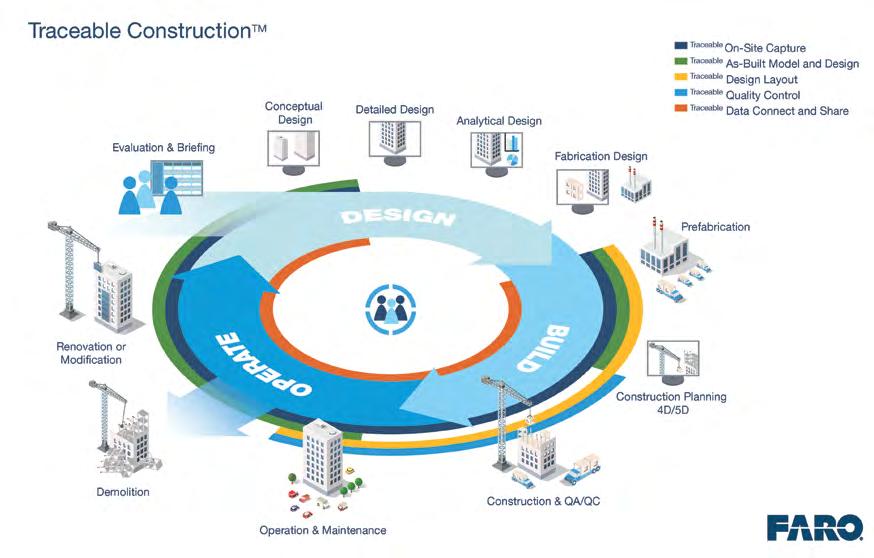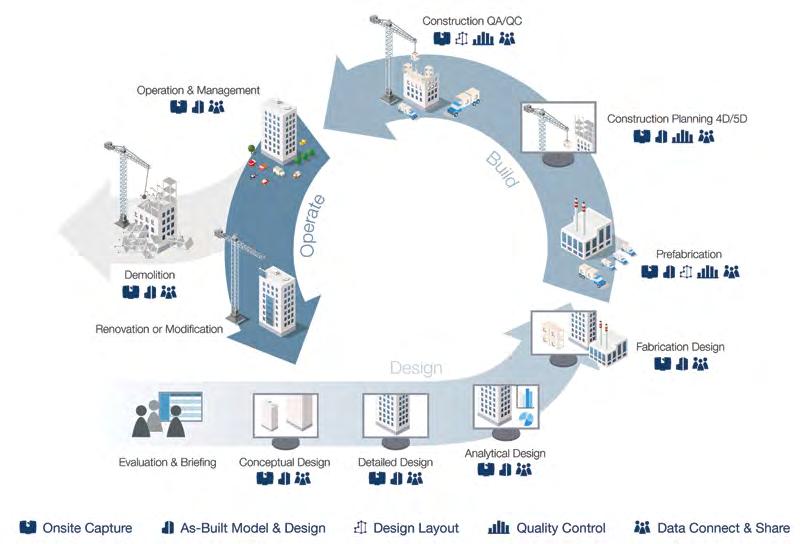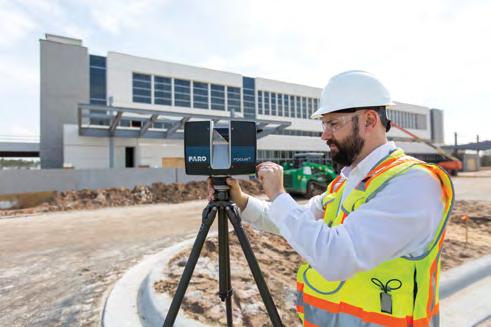
6 minute read
Digitalisation of the engineering and construction industry Achieving project value improvement with an informed construction lifecycle
by Chew Beow Kwan, Product Marketing Manager, FARO Technologies Inc Achieving project value improvement with an informed construction lifecycle.
Digital technologies have transformed entire industries in the last decade, impacting lives on both personal and professional fronts. Companies have had to reinvent themselves to evolve with the times, enhancing productivity, sustainability and adaptability, all in order to stay relevant to their target audiences. Interestingly, however, firms within the engineering and construction (E&C) industry have, for the most part, bucked this trend and retained a majority of the trade’s traditional methods. According to the World Economic Forum [1], the E&C industry continues to operate today as it has for the past 50 years, heavily relying on manual labour, mechanical technologies and legacy business models. The lack of productivity growth remains prevalent throughout the industry, leading to delays in the completion of projects and material wastages, which affect project bottom lines significantly. The industry’s underinvestment in digitalisation has had a profound impact on productivity. Firms are held hostage to issues such as manpower challenges (with manual data tracking and verification) and the need for re-work due to an inability to accurately track project progression. That said, the increasing complexity of building designs, coupled with a severe shortage of skilled workers, have accelerated the digital push, especially for companies who want to stay relevant and profitable. An easy way for E&C industry players to visualise the benefits of digitalisation is to picture the conventional construction lifecycle taking on a digital form, where real-time information on a project is readily available to all stakeholders on a single platform. Right from the design phases through to the build and operate phases, a project is clearly laid out and its progress can be tracked. The data transparency enables teams to collaborate effectively, allows foremen to identify and manage any issues early, and helps owners monitor project safety. Based on The Boston Consulting Group’s research [2], full-scale digitalisation across the E&C industry can generate an estimated value of USD 1.0 trillion to USD 1.7 trillion in annual cost savings. In the same vein, McKinsey & Company [3] advocates improving the value of capital projects through more efficient spending. By integrating specific tools and practices, project owners have historically managed to realise better project value of more than 10% in savings - either by reducing the project’s capital or operating expenditure, increasing its output, or accelerating its completion date so that profits can be achieved earlier. The next question, naturally, is whether there are solutions in the market to support the E&C industry’s digitalisation efforts.
Enabling an informed construction lifecycle Traceable Construction, from FARO, is an approach that leverages the availability of accurate data throughout various stages of construction. In the E&C industry context, the traceability concept describes how one can follow through on a building’s complete lifecycle - whether in the design, build, or operate phase. Across any building’s lifecycle, there are five typical aspects of traceable construction, that may be relevant at any given point in time.
On-site Capture The basis of an informed construction lifecycle is accurate and reliable 3D data. Today, there are ultra-portable laser scanners and intuitive data processing software that work seamlessly together to enable quick and easy acquisition and registration of point cloud data. Project owners and managers have the option of choosing between terrestrial capture, mobile capture, and airborne capture for various applications.
As-built Model & Design By capturing as-built conditions, stakeholders can ensure a traceable conversion of scan data into BIM designs, for further planning and design of building projects, based on the context of reality. High-speed, high-fidelity laser scanners, coupled with suitable processing software, enable fast and efficient creation of 2D-, 3D-, and BIM models that can be fully integrated into major Autodesk building design systems.
Design Layout Conversely, subcontractors can employ laser projectors to visualise designs from CAD plans and models on real objects. This facilitates the prefabrication of components, increases the precision of installation and assembly, and allows users to identify deviations from CAD plans onto components (eg display of unevenness in the floor).
Digitalisation of the construction lifecycle allows project owners to make better, informed decisions over the course of the building’s development stages. Typical aspects of traceable construction.

Quality Control To ensure continuous quality control on construction sites, workflows need to quickly and precisely record current status, compare the status-quo with CAD plans, and report any deviations. Foremen and site managers can rely on laser scanners to perform immediate, real-time build, and verify analysis throughout the entire project to improve efficiency, shorten timelines, and reduce material wastage.
Data Connect & Share With cloud-based hosting solutions, project participants can share scan data easily and securely on standard file types and widely used platforms. The ‘single source of truth’ enables transparency and traceability on project progression at any stage.
Realising greater value with Traceable Construction Within the Traceable Construction framework, there are several practical ways that project owners can seek to realise tangible value improvement. Some applications that further elaborate its value include the following:
Improving construction quality and reducing re-work With traditional construction methods, site managers primarily record data with pen and paper. In these scenarios, the information tends to be outdated and issues are typically uncovered only at a later stage. This then results in the need for re-work and material wastage, and causes a delay in timelines as well as a decline in efficiency. On the other hand, with 3D digital methods, engineers and site managers can rely on laser scanners to capture a construction site completely and precisely. This real-time digital data can be continuously monitored and analysed using data processing software, allowing any defects or non-conformity to surface more easily and quickly, which makes it possible for problems to be resolved earlier.
Enabling fast and precise assembly without templates Using a 3D laser projection system, fabrication shops can speed up the assembly workflow for structural and prefabricated elements. Design data can be projected on to building components to enable large-scale laser guided assembly, offering a quick and accurate way to position these elements. It also eliminates the need for manual measurements and physical templates, which optimises the use of manpower, time and budget. Maintaining a clear overview of as-built data throughout project duration Complete, efficient, and accurate documentation of construction projects carried out at various stages of the construction process adds value to the delivery process and to the as-built dataset. But even more valuable is the use of laser scanning in building supervision. Timely monitoring of construction progress is ensured by the rapid recording of construction work.
3D laser projection systems allow workers to conduct large-scale, laserguided assemblies, without the need for physical templates.

The data collected supports the precise positioning of formwork in concrete and columns in steel construction. It also serves to control construction work and to record progress, structural damage, and health and safety compliance. The E&C industry is now at the cusp of a new era. Reliable integrated solutions like laser scanners and software platforms readily offer companies the opportunity to turn things around and implement digital strategies to their processes quickly and easily. The firms that do so are likely to emerge as leaders and enjoy tangible first-mover advantage. Continuous construction verification allows managers to spot any critical issues and make quick, informed decisions, to move the project forward.

FARO Headquartered in the US, FARO develops and markets computer-aided measurement and imaging devices, and software, for vertical markets such as 3D Manufacturing, Construction BIM, Public Safety Forensics, 3D Design, and Photonics.
References [1] World Economic Forum: ‘Shaping the Future of Construction: Future Scenarios and Implications for the Industry’, March 2018. [2] The Boston Consulting Group: ‘Companies in the Engineering and Construction Industry Must Act Now to Avoid Future Disruption’, 5 June 2018. [3] McKinsey & Company: ‘Capital project value improvement in the 21st century: Trillions of dollars in the offing’, August 2018.









